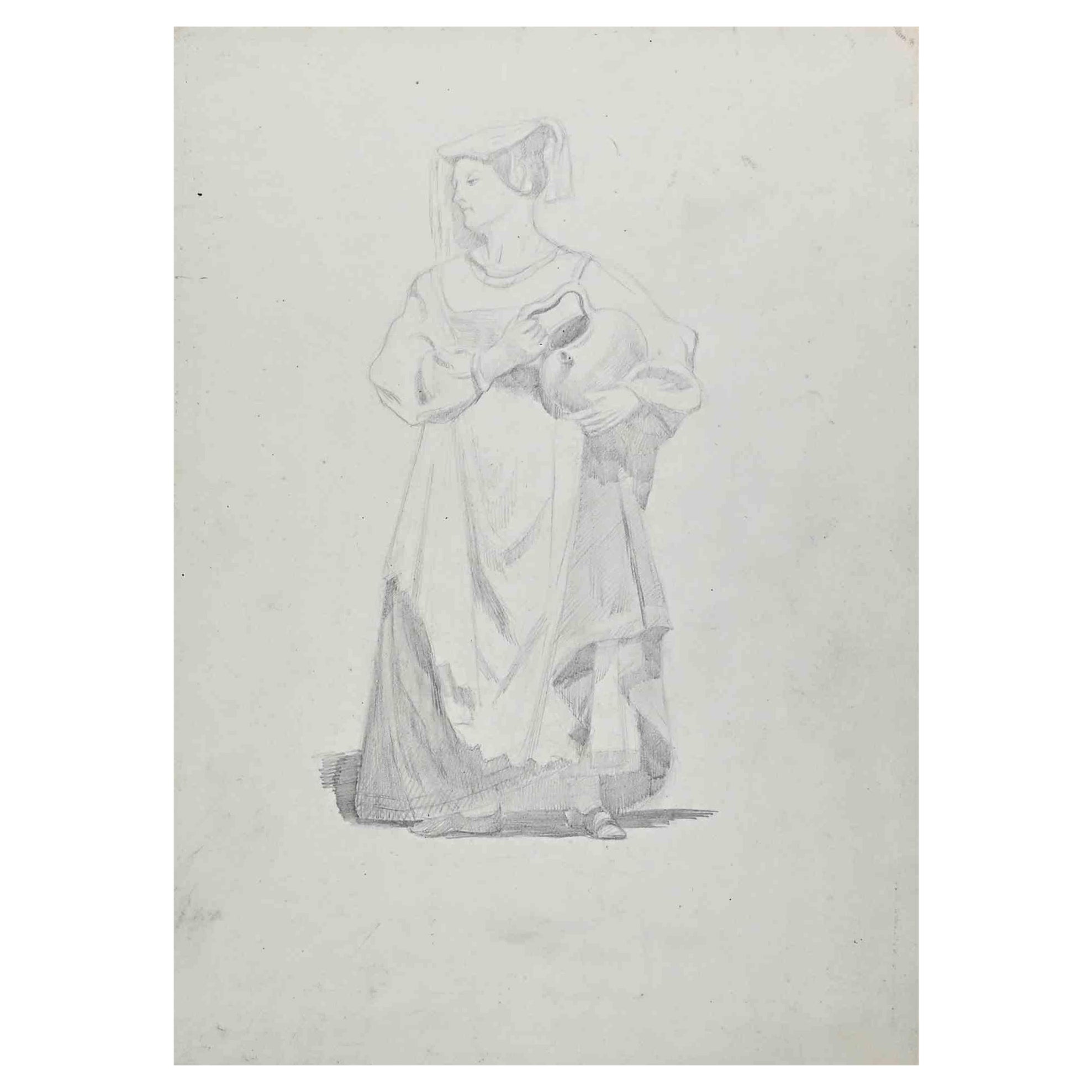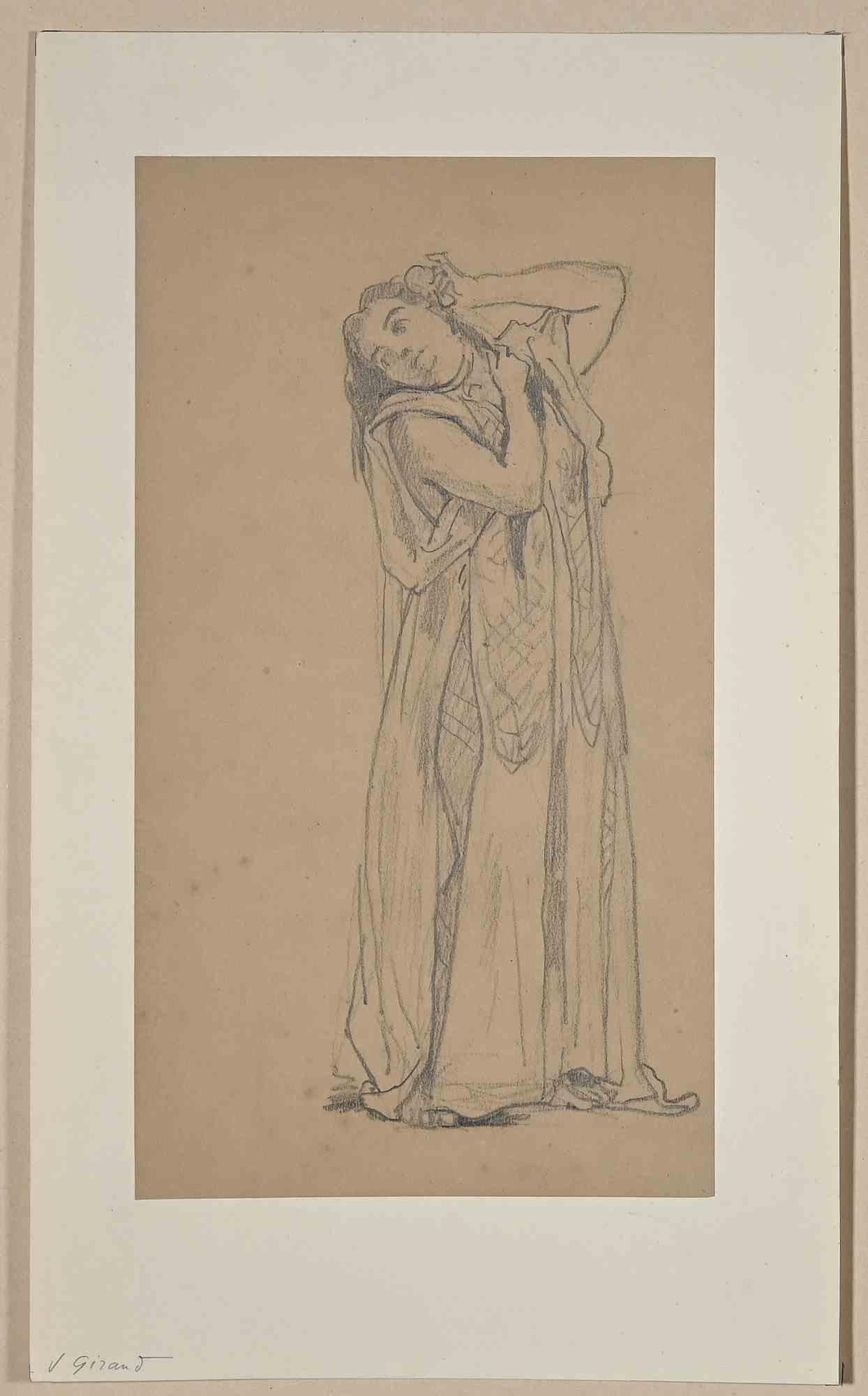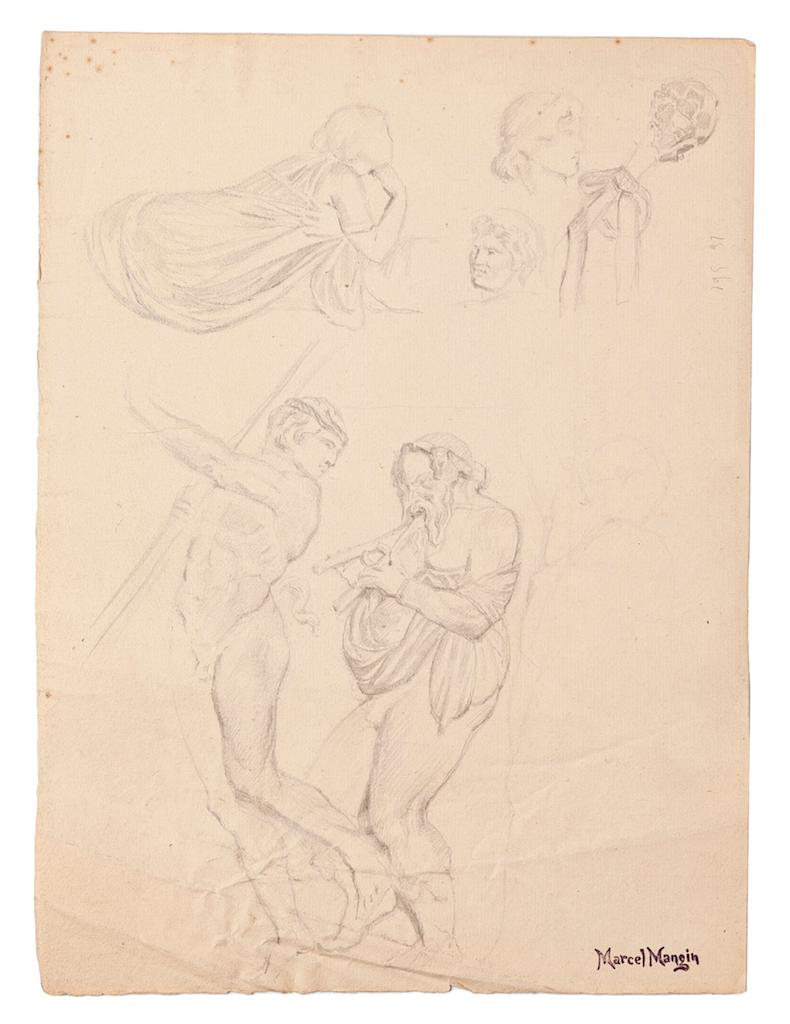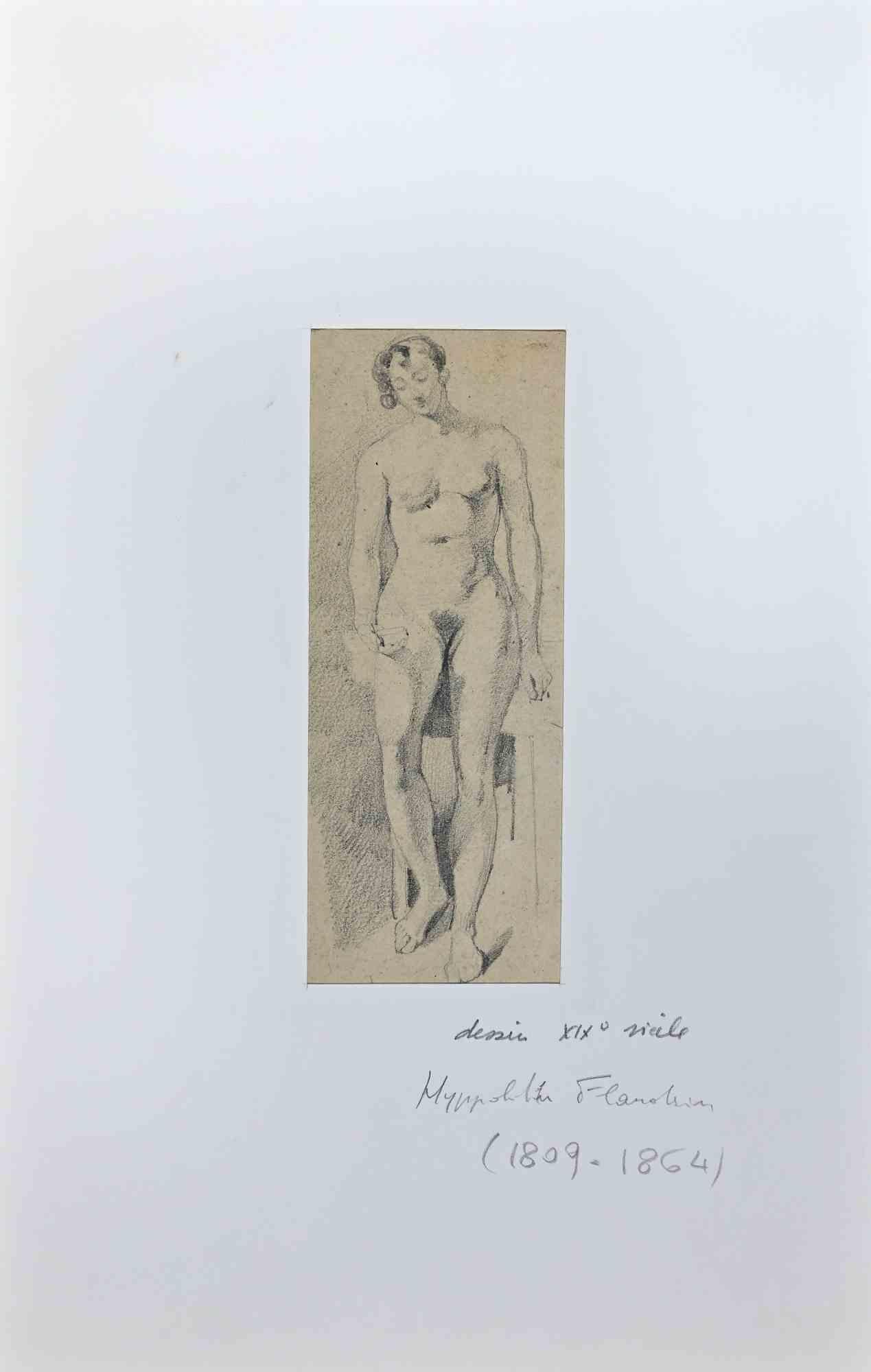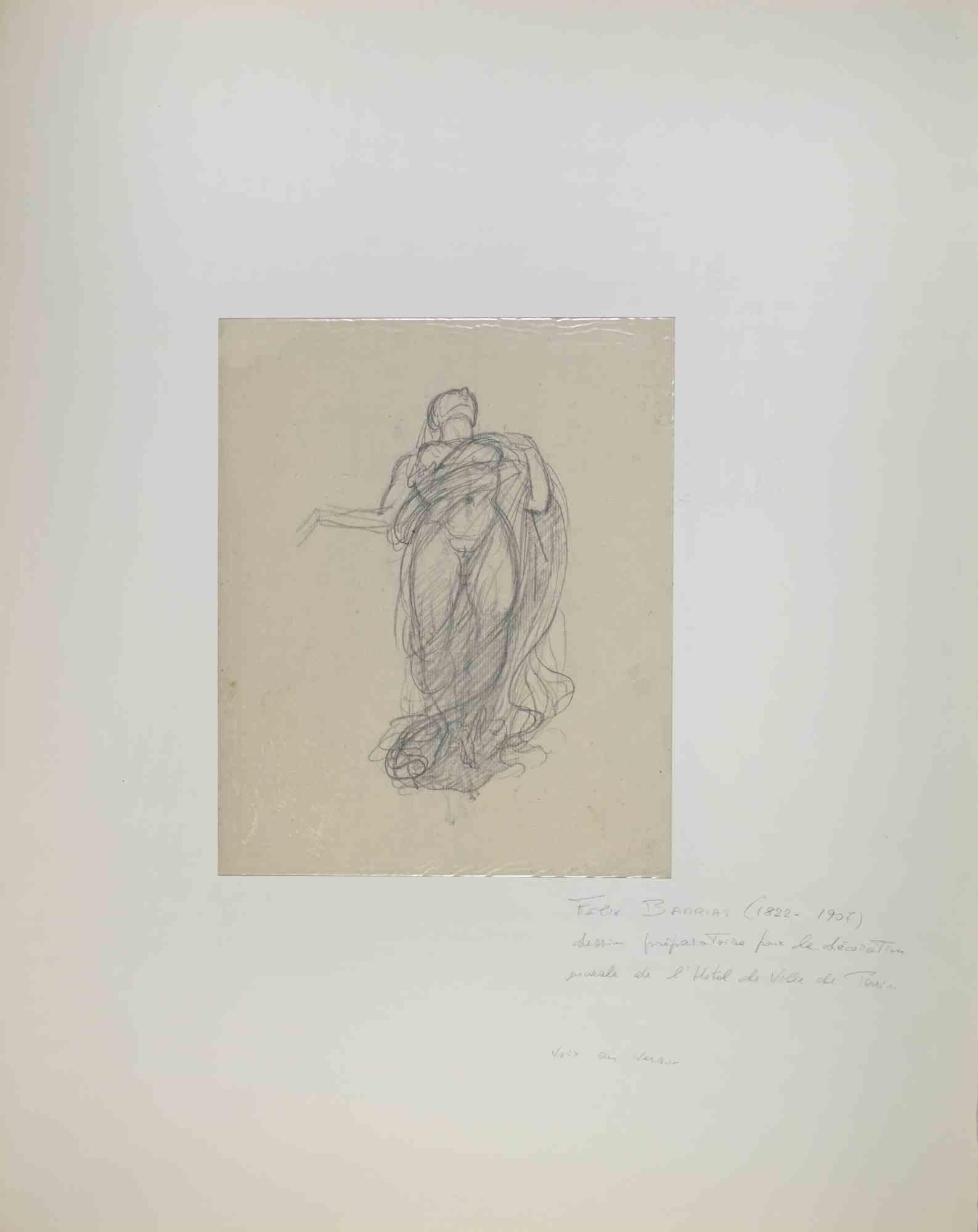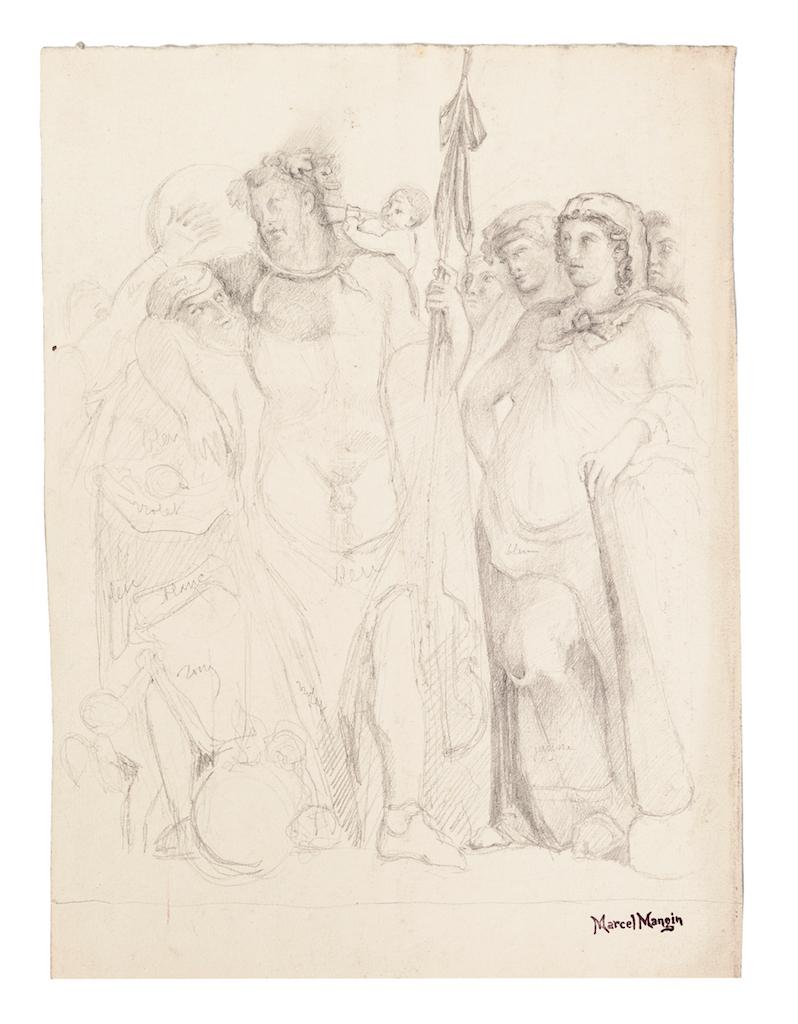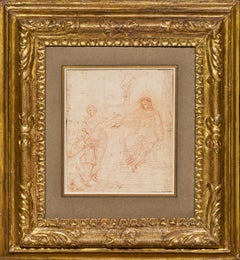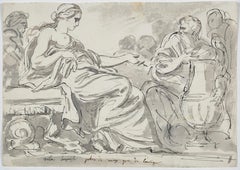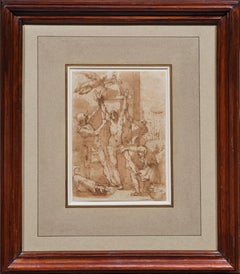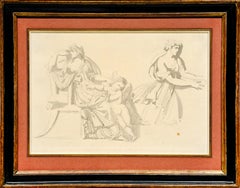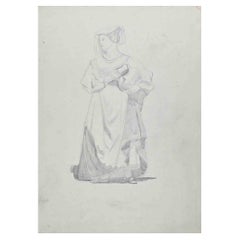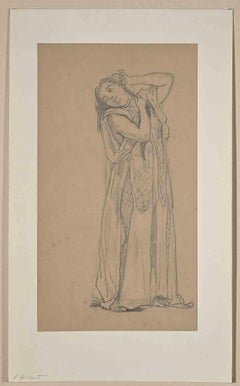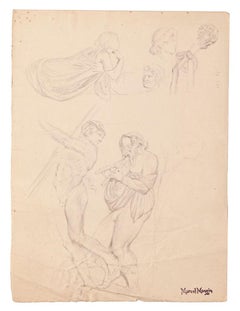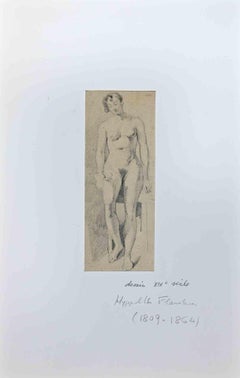Items Similar to A Study for the Angel of Saint-Severin church in Paris, by Paul Flandrin
Want more images or videos?
Request additional images or videos from the seller
1 of 11
Paul FlandrinA Study for the Angel of Saint-Severin church in Paris, by Paul Flandrin1840
1840
$4,160.19
£3,098.05
€3,500
CA$5,743.71
A$6,367.75
CHF 3,346.50
MX$77,930.84
NOK 41,794.41
SEK 39,228.23
DKK 26,647.83
About the Item
After the restoration of the Saint-John chapel’s frescoes at the Saint-Severin church in Paris in 2022, the drawing presented here is a moving testimony to their creative process. It highlights Paul Flandrin's role in the design and execution (between 1839 and 1841) of this decorative programme, alongside his older brother Hippolyte, who had been entrusted with the project.
1. Paul Flandrin, a life in the complicity of his brother Hippolyte
Along with Édouard Bertin and Alexandre Desgoffe (who later became his father-in-law), Paul Flandrin is one of the few pupils of Ingres to have specialized in landscape painting. Born into a family of Lyonnais painters , Paul took his first drawing lessons from his eldest brother Auguste (1804-1842), who became thereafter a lithographer and a portraitist. After studying at the Lyon School of Fine Art, he moved to Paris with his other brother Hippolyte, where they joined Ingres' studio in 1829.
In 1832, Paul won the historical landscape sketching competition, but failed to win the grand prize. Without a pension, he decided in December 1833 to join his brother Hippolyte, winner of the Prix de Rome in 1832, at the Villa Médicis in Rome to further his training. His attraction to landscapes was strengthened by the many trips he made with his brother to the Roman countryside and by the discovery of the bright Italian light. In Rome, Paul also became drawing teacher to the children of Prince Borghese, developing his taste for drawing.
Back to Paris in 1838, they exhibited at the Salon of 1839, where Paul received a second-class medal. Not yet able to make a living from his painting, he assisted his brother, who had just received his first major commission for the church of Saint-Severin in Paris: the decoration of the chapel of Saint-John the Evangelist which was completed in March 1841. In 1842, Paul was in turn commissioned to decorate the baptismal font chapel at Saint-Severin. Thereafter, the two Flandrin brothers, united by a tender complicity, continued to work together on various public and private décor programs (Château de Dampierre, Saint-Germain-des-Prés in Paris, Saint-Paul de Nîmes, Saint-Vincent de Paul in Paris) until Hippolyte's departure for Rome in 1863 (where he died in 1864).
In 1870, fleeing the war between the Imperial and Prussian armies, Paul Flandrin was received by the painter Auguste Pichon in Angers. After a year and a half in Angers, Paul Flandrin returned to Paris in 1872. Settled at 10 rue Garancière, he divided the rest of his time between his Paris studio and frequent painting trips to the provinces. For the next thirty years, the painter participated annually to the Salon until his death in March 1902, at the age of ninety-one.
2. The frescoes of the Saint-John chapel at Saint-Séverin church in Paris
The commission for the frescoes of the Saint John chapel was the first major project entrusted to Hippolyte Flandrin, who was assisted by his brother Paul and the painter Louis Lamothe (1822-1869), another of Ingres's pupils, also from Lyon.
The iconographic program combines Gospel scenes with scenes from the life of Saint John the Evangelist. The narrative begins on the right-hand side upper wall, with The Vocation of Saint John and Saint James , and is being pursued on the left-hand side wall with The Last Supper (in which Saint John is depicted next to Christ) with Saint John writing the Apocalypse above it. The final episode is depicted opposite the Last Supper on the right-hand wall; it is the Martyrdom of Saint John, during which he is immersed in a cauldron of boiling oil.
The narrowness of the chapel, while allowing a two-register representation, makes it difficult to photograph these frescoes without distortion.
Our angel is preparatory (without wings) to the one depicted in the "Saint John writing the Apocalypse" fresco. The presence of this angel is a literal illustration of the very beginning of the Apocalypse: "The revelation of Jesus Christ, which God gave him to show to his servants the things that must soon take place. He made it known by sending his angel to his servant John." We see in our drawing the foreshadowing of the angel's imperious gesture, as he gazes down at Saint John, while pointing with his raised right hand to the celestial world and inviting him with his left hand to transcribe this revelation onto the scroll resting on the evangelist's laps.
While Hippolyte was responsible for the overall iconographic program, our drawing bears witness to Paul's role in the compositional ideas, for which he produced several preparatory drawings, such as this one. Once the motifs were in place on the walls , the paintings were also jointly executed, and in the words of Stéphane Paccoud, "it would be futile to try and distinguish their respective hands".
A commentator wrote about this scene in 1841 in the Revue des deux Mondes: "The upper ogival painting shows Saint John in his old age, writing the Apocalypse under the dictation of an angel, on the island of Pathmos. This piece is the most completely successful of the four. The Saint John is very handsome, with his tawny complexion, immense white beard and body furrowed by years and austerities. The angel has an admirable pride of movement and authority of gesture; the coloring is also very satisfying."
3. Framing
Our drawing has been framed in a gilded and stuccoed wooden frame from the same period as the work.
Main bibliographical references
Hippolyte, Auguste et Paul Flandrin: une fraternité picturale au XIXe siècle, exhibition catalog, Paris, Musée du Luxembourg and Lyon, Musée des Beaux-Arts, 1984
Hippolyte, Paul, Auguste. Les Flandrin artistes et frères, exhibition catalog edited by Elena Marchetti and Stéphane Paccoud, Musée des Beaux-Arts de Lyon, 2021
- Creator:Paul Flandrin (1811 - 1902, French)
- Creation Year:1840
- Dimensions:Height: 15 in (38.1 cm)Width: 11.38 in (28.91 cm)
- Medium:
- Movement & Style:
- Period:
- Condition:10 3/8’’ x 6 7/8’’ (26.5 x 17.4 cm) - Framed : 15’’ x 11 3/8’’ (38 x 29 cm) Titled upper right, signed and dated "March 17, 1840" lower left 19th century French frame in stuccoed and gilded wood.
- Gallery Location:PARIS, FR
- Reference Number:1stDibs: LU1568214795182
About the Seller
5.0
Vetted Professional Seller
Every seller passes strict standards for authenticity and reliability
Established in 2020
1stDibs seller since 2021
10 sales on 1stDibs
Typical response time: 3 hours
- ShippingRetrieving quote...Shipping from: PARIS, France
- Return Policy
Authenticity Guarantee
In the unlikely event there’s an issue with an item’s authenticity, contact us within 1 year for a full refund. DetailsMoney-Back Guarantee
If your item is not as described, is damaged in transit, or does not arrive, contact us within 7 days for a full refund. Details24-Hour Cancellation
You have a 24-hour grace period in which to reconsider your purchase, with no questions asked.Vetted Professional Sellers
Our world-class sellers must adhere to strict standards for service and quality, maintaining the integrity of our listings.Price-Match Guarantee
If you find that a seller listed the same item for a lower price elsewhere, we’ll match it.Trusted Global Delivery
Our best-in-class carrier network provides specialized shipping options worldwide, including custom delivery.More From This Seller
View AllStudies for the Judgment of Solomon, a double-sided drawing by Simone Cantarini
Located in PARIS, FR
In this double-sided red chalk study, Simone Cantarini offers us a double reflection on the theme of the Judgment of Solomon. This sheet reveals his precise style and his sense of de...
Category
1640s Old Masters Figurative Drawings and Watercolors
Materials
Chalk, Laid Paper
Study in the Antique Style, a neoclassical drawing by Augustin Pajou
Located in PARIS, FR
In this lively and fresh drawing, probably taken from one of the artist's notebooks, Pajou presents us with a composition freely inspired by antiquity, as a souvenir of a visit to th...
Category
1750s Old Masters Figurative Drawings and Watercolors
Materials
Ink
The Martyrdom of Saint Bartholomew, a preparatory drawing by Alessandro Casolani
Located in PARIS, FR
This powerful pen and brown ink wash drawing is a study for an altarpiece depicting The Martyrdom of Saint Bartholomew. Signed and dated 1604, it was painted at the end of his life b...
Category
Early 1600s Old Masters Figurative Drawings and Watercolors
Materials
Ink, Pen
Frieze of antique figures, a drawing by the sculptor Antoine-Denis Chaudet
Located in PARIS, FR
Faithful to the neo-classical taste, sculptor Antoine-Denis Chaudet presents us with a frieze of antique figures executed in gray wash over pencil strokes, which is likely inspired b...
Category
Early 1800s Old Masters Figurative Drawings and Watercolors
Materials
Paper, Pencil, Ink
Study for the Spring (preparatory to the Four Seasons) by René-Marie Castaing
Located in PARIS, FR
René-Paris Castaing, winner of the Grand Prix de Rome in 1924, left a large body of work, both sacred and secular. Many churches in the Pyrénées-Atlantiques, in South-West France still bear witness to the diversity of his talent. In 1942, he began a major decoration project for the Château de Diusse, in the north-east of the county, including an allegory of the four seasons. The vigorous pastel we are presenting here is a study for Spring, depicted as Flore undressing. This commission was a veritable swan song for the artist, who died a year later at the age of 47.
1. René-Marie Castaing, the great inter-war painter in Pau
René-Marie Castaing was born in Pau on December 16th 1896. His father, Joseph Castaing, was also a painter: he was the official portraitist of Pau's high society, which was particularly cosmopolitan at the end of the century, when many rich foreigners spent the winter in Pau, taking advantage of the mild weather to enjoy an outdoor lifestyle punctuated by hunting, horse ridings and golf.
René-Marie Castaing was admitted to the Ecole Nationale Supérieure des Beaux-Arts in Paris in April 1920 and entered the studio of Paul-Albert Laurens (1870-1934). In 1924, he was awarded the First Grand Prix de Rome for Painting, which earned him a stay at the Villa Médicis for more than three years. He then returned to Pau in 1928, where he lived until his death.
Castaing's work is marked by the academic tradition, in which drawing plays as important a role as painting. Although his drawings are often sketches that help to set up large painted compositions, they stand as independent artworks in which the artist fully expresses the vivacity of his talent.
Castaing was a fervent Christian and religious painting played an essential part in his work, as shown by the decorations he created for the churches of Bizanos, Borce, Bidache and Salies-de-Béarn. The painter also created several secular decorations, such as that for the dining room of the Villa Saint-Basil's in Pau in 1935, and the Hunting at the Albret’s time commissioned in 1940 by the Prefecture of Pau. The décor created in 1942-1943 for the Château de Diusse, a mansion located north-east of Pau, was his last large-scale décor, as the painter died shortly after its completion on December 8th 1943.
2. Description of the drawing
Our pastel depicts an eminently secular theme: Spring is embodied by Flore, crouching on the ground with one knee touching the ground. She reveals her ample bosom by removing her shirt, her arms raised above her shoulders to undress.
Given Castaing's classical training at the Beaux-Arts and the influence of ancient statuary...
Category
1940s Art Deco Nude Drawings and Watercolors
Materials
Pastel
Allegory of Chastity, a drawing attributed to G. Porta with great provenance
Located in PARIS, FR
This magnificent drawing from the Venetian Renaissance intrigues us in many ways. It depicts an allegorical composition whose meaning partly escapes us: a veiled figure seated on a stone bench (which we have identified as Chastity), seems to be turning away from a woman's bust beside her, below which are two rabbits, a traditional allegory of fertility, but also sometimes of lust.
This drawing, executed on blue paper, undoubtedly belongs to the Venetian Renaissance. The inscriptions on the back of the old mounting board indicate the various attributions considered by its last owner, the British painter and art historian Sir Lawrence Gowing. We have retained the attribution to Giuseppe Porta proposed by art historian John Arthur Gere as the most relevant.
We were incredibly fortunate to find a hexagonal frame of a very similar format for this drawing, the upper corners of which were formerly cut (irregularly). This 17th-century Dutch frame comes from an aristocratic collection in Lombardy, and creates a kind of fascinating chase around this Venetian drawing...
Category
16th Century Figurative Drawings and Watercolors
Materials
Chalk
You May Also Like
Woman - Original Drawing on Paper by A..E Viollet-Le-Duc - Mid 19th Century
Located in Roma, IT
Woman is an Original Pencil Drawing realized by Adolphe Etienne Viollet-Le-Duc (1817-1878).
Good condition on a white paper included a green cardboard passpartout (48x34 cm).
No Si...
Category
Late 19th Century Modern Figurative Drawings and Watercolors
Materials
Pencil
Young Lady - Original Drawing in Pencil by Eugène Giraud - Late 19th Century
By Eugène Giraud
Located in Roma, IT
Young Lady is an Original Drawing in pencil realized by Eugène Giraud in the Late 19th Century.
Applied on a Cardboard, included a blue Passepartout: 41 x 33 cm
Good conditions.
T...
Category
Late 19th Century Modern Figurative Drawings and Watercolors
Materials
Pencil
Study of Figures- Drawing on Paper by Marcel Mangin - Late 19th Century
By Marcel Mangin 1
Located in Roma, IT
Study of Figures is original drawings on ivory paper, realized by Marcel Mangin (French, 1852 - 1915), with the stamp of artist"Marcel Mangin" on the low...
Category
Late 19th Century Figurative Drawings and Watercolors
Materials
Pencil
Nude of Woman- Original Drawing by Jean-Hyppolyte Flandrin - Mid-19th century
By Jean-Hyppolyte Flandrin
Located in Roma, IT
Nude of Woman is an Original Pencil Drawing realized by Jean-Hyppolyte Flandrin.
The little artwork is in good condition on a yellowed paper.
Signature by pencil on the back of the drawing, included a white cardboard passpartout (33.2x21 cm).
Jean-Hippolyte Flandrin (23 March 1809 – 21 March 1864) was a 19th-century French painter. His celebrated 1836 work Jeune Homme Nu...
Category
Mid-19th Century Modern Figurative Drawings and Watercolors
Materials
Pencil
Figure - Drawing by Felix Barrias - Late 19th Century
By Félix Barrias
Located in Roma, IT
Figure is a Pencil drawing realized by Félix Barrias (1822 - 1907) in the Late 19th Century.
Good condition on a yellowed paper.
Category
Late 19th Century Modern Figurative Drawings and Watercolors
Materials
Pencil
Study of Figures - Drawing on Paper by Marcel Mangin - Late 19th Century
By Marcel Mangin 1
Located in Roma, IT
Study of Figures is original drawings on ivory paper, realized by Marcel Mangin (French, 1852 - 1915), with the stamp of artist"Marcel Mangin" on the low...
Category
19th Century Figurative Drawings and Watercolors
Materials
Pencil
